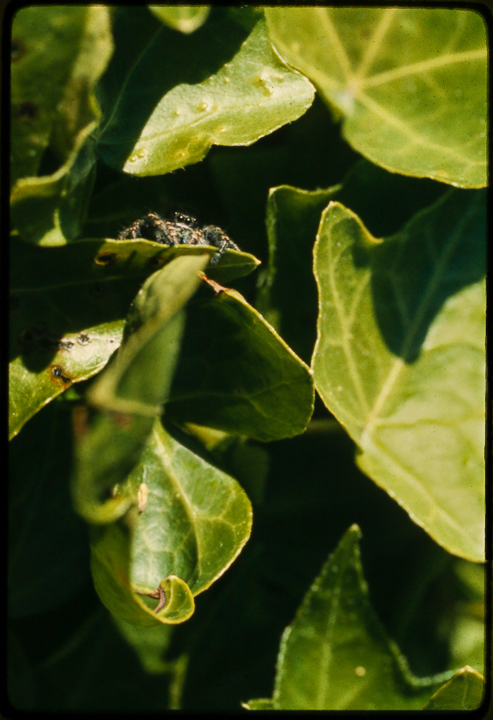About Me
I became smitten with Jumping spiders in the early 1980s, at the age of fifteen, when I first saw one in my backyard staring back at me from an ivy plant. If you haven’t experienced a Salticid (the scientific name of the Jumping spider family) looking around, taking in its environment, and sometimes staring right at you, I recommend the experience.
I began to photograph them and soon after I came across a book of insects in flight, Borne on the Wind, by pioneering high speed nature photographer Stephen Dalton. I decided that I wanted to capture Jumping Spiders mid-leap, just as Dalton had done with flying insects. I liked to tinker and build things and my father, an electronics technician, helped me build my first high speed photography system in 1981.
With this system I was able to take a number of photos of Salticids jumping. I went off to college, with the goal of becoming a Jumping spider biologist. A year or so later, I tried my hand with the photography again, and improved my results. Even the best images I took were rather fuzzy and I now realize it’s because the flash I was using was probably about 1/1000 of a second in duration, which is not fast enough to really freeze the motion. The following year, when I tried to resume the work, the electronics had stopped working. I put everything in a box and moved on to other things.
Fast forward more than 30 years. I didn’t become a biologist, but an aerospace engineer! But my love of Salticids had never gone away. With the skills I had developed as an engineer and hobbyist, I decided to tackle high speed photography again. I built a more sophisticated electromechanical system, figured out how to make the flashes of shorter duration and also benefited immensely from the advantages of digital photography. There’s no comparison between the experience of taking a handful of images on film and then waiting a week to see them, vs. taking as many as I want, seeing them instantly, and making changes on the fly.
Recently, I discovered that Jumping spiders are having their moment. There is a Jumping spiders group on Facebook with 80,000 members and these people love their spiders. People breed them and sell them as pets by mail order, and there are multiple books written about how to keep them as pets and even train them (I have my doubts about that)! Here is an article from CNN about the new popularity of Jumping spiders.
Clearly, the popularity of Salticids is due to their two huge eyes, their colorful, sometimes fuzzy, bodies, and their visual behavior. Such fondness is not extended to other spiders (to say the least), most of which have poor vision and rely on sensing vibrations to navigate their way through life. It just shows how easily, and eagerly, we humans project ourselves onto other beings. A Jumping spider may look cute to us, but no one would ever say that about a Black Widow. Yet, they are both the same sort of predator. Any other animal that they encounter is either a potential threat, prey, or a mate, and they have evolved to respond accordingly, with the capabilities and senses that they have.
Be that as it may, I embrace my psychological projections onto Jumping spiders. They are my favorite animals, they delight me, and I created this web site to share my photographs and celebrate this particular aspect of nature’s beauty. I hope you enjoy it.

Phidippus johnsoni in the ivy. One of the first jumping spider photos I took in 1980. Below are photos I took in 1982 and 1983.


